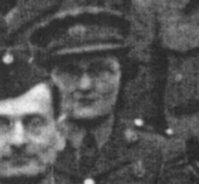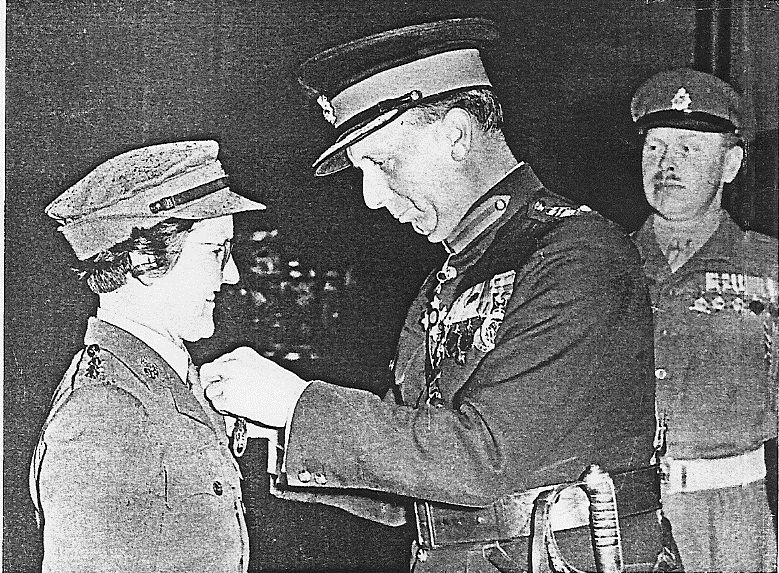At the age of 15 Barbara Culleton arrived in London on her own and found digs and secretarial work. It was 1933 and in Germany Adolf Hitler was coming to power.
War clouds were gathering. On the 9th September 1938 the Women’s Branch of the British Army the ‘Auxiliary Territorial Service’ was formed. Within two months Barbara had enlisted into Princess Louise Kensington Regiment as a volunteer (as ATS privates were then called).
The day before war was declared she was embodied into the Army and was posted to the War Station Railway Training Centre at Longmore and remembered having to help put rolling stock back on the tracks.
It was in July 1941 while she was at her next posting to 12 Field Training Regiment Royal Artillery at Bordon that she was first interviewed and told that she had been selected to become an officer. She was reluctant and turned it down until at a further interview she was asked to consider being involved in training for 'urgent, very secret and possibly dangerous' work. Thinking that it sounded exciting she agreed. Final selection depended on the results of voice tests carried out using a simple R/T set, put together by Royal Corps of Signals personnel and selected radio hams.
Then came a period of more detailed training, still at a secret location 'somewhere in Essex', including maintenance of the sets; deciphering/enciphering codes and the use of a rifle and pistol (although these were not issued).
This was followed by a shortened Course at No.1 ATS Officer Cadet Training Unit, Edinburgh where she gained her Commission. The date 7 September 1941. An immediate posting to Auxiliary Units – Special Duties Section with the rank of 2nd Subaltern followed. The Headquarters, Auxiliary Units, was at Coleshill House, near Highworth, Wiltshire and she was Administrative Assistant to Senior Commander Beatrice Temple.
Temple recorded in her diary; Monday Dec 1 1941 Haverhill to Doncaster in Major Winterborn‟s car. Saw Pye and Culleton (rather taken by Culleton, cheerful and keen) Spoke to Major Winterborn about lack of organisation at HQ.
Monday Dec 8 1941 Swindon to pick up little Culleton - cheerful, seems pleasant and willing. Handed over files.
The Special Duties were billeted at nearby Hannington Hall, owned by the Fry family.
For the first few months Barbara did not spend much time at HQ but was on her own travelling throughout the country inspecting the control stations as they were constructed and equipped.
Senior Commander Beatrice Temple also travelled widely and so Barbara returned to Hannington Hall to cover for her while she was away. Eventually the threat of invasion subsided and she admits the work became somewhat boring.
Senior Commander Temple was able to arrange a posting for her to Combined Operations at the War Office in London. She should have joined a WRAF, and Wren officer working in the ‘most secret’ registry but they failed to materialise so once again found that she was on her own. She describes Lord Louis Mountbatten who had the office across the passage from hers, as a real poppet. One day while in the corridor she attempted to double lock her door but with arms full of mail bound for Churchill and the War Cabinet, she managed to drop the lot. At that very moment Lord Louis and his Aide-de-Camp came out of his office and all three ended up on the floor laughing and picked it up.
For a couple of months at the end of 1943 she was seconded to the Civil Affairs Staff College at Wimbledon an organisation making preparations for post war Britain.
In December 1943 she was posted to Monty’s 21st Army Group Headquarters, where she joined the Movement Control Section making plans for D-Day. - studying the tides, moon and turn-around times for landing craft etc.
The Plans complete, she returned to the War office to an administration post dealing with ATS Officers compassionate leave, sickness, travel etc
The on 1st January 1946, the war over and she was released from regular service. In September of the following year she was back in the Territorial Army with 916 (mixed) Transport Company Royal Army Service Corps, Territorial Army as a subaltern.
Women had served in the Auxiliary Territorial Service on an emergency engagement until 1949. On the 1 February the Women’s service became a part of the Regular & Territorial Army with the title Women’s Royal Army Corps. On the 3rd May 1955 Captain Barbara Culleton WRAC was awarded the Territorial Decoration for serving her Country. Brigadier E.R. Caffyn pinned on her medal and whispered “my wife told me to be careful where you pin it !” which is why the photo has her smiling.
She continued to serve until 12 December 1968 when she reached the upper age limit and so had to leave. Barbara Culleton had served her Country for 30 years.
Auxiliary Units (Signals) A.T.S - Barbara Culleton - In Her Own Words
Enrolment in the Auxiliary Territorial Service was for me on 11 Nov 1938 and little did I imagine that by June 1941, a recommendation would be made for me to be called before a Cadet Board. However, three weeks later, I was interviewed again and told that volunteers were urgently required for very secret and possibly dangerous work and that selection would mainly depend on the result of a voice test. This to be carried out at a secret location, “somewhere” in Essex (possibly at Bachelors Hall, Hundon). Then came a period of a technical training (I suspect in the Great Yeldham area); the use of fire-arms, although these were not issued, followed by a two-week Course at No.1 ATS OCTU, Edinburgh and ultimately a posting to Auxiliary Units on 7.9.41.
At the outset it was the general rule that ATS Officers in the Aux Units would be accommodated, with board, in the civilian billets (usually selected by the local Police) – attached to the nearest Area HQ for administration – be dependent on the Royal Corps of Signals personnel for providing transport (usually a 15 cwt truck or a 3 ton lorry) and for them to carry out relevant tasks on site.
In these early days, the stations were all above ground (the “dugouts” came later) in wooded areas alongside fields, within forests, etc, wherever there was adequate cover for a wooden, Nissen or Romilly hut to be sited. An unusual one for me was a summerhouse in the grounds of a stately home in Yorshire (Hickleton Hall). As it happened the Hall was also the location of the Area HQ.
Local requirements varied from area to area so, most probably, did work programmes and the number of personnel involved. As far as is known, most Control Stations were manned initially by a single operator until fully operational and then by 2, 3 or 4 personnel.
Watches were programmed through the day for establishing contact with up to 6/8 outstations. Eventually this link-up would enable secret information to be passed from network to network to the appropriate sources. An additional task was to listen out for broadcasts by suspect agents. Any contact made had to be notified immediately to the Intelligence Section at the local Headquarters. At no time as Morse Code used by Aux Units.
The early versions of the radio sets were particularly sensitive to sunspot and thunderstorm activity, especially so a US Transreceiver, on temporary loan. Together with occasional interference from Tank Unit’s radio, the tasks of a solo operator became somewhat chaotic at times.
As soon as a network was fully operational, it was a case of packing one’s bags and heading for another area, often at the opposite end of the country, to carry out the same procedures as before (this time by Staff car!).
Security at all times and everywhere was very tightly observed. No indication was ever given as to numbers of personnel involved; numbers and / or locations of stations. Only as much information as was needed to be known was given out at any one time. For identification purposes, a War Office telephone number was given to each individual to be revealed if the standard reply to a challenge was not accepted and further confirmation was required.
In early December 1941, I was taken off operational duties and posted to HQ Aux Units, Coleshill House, near Highworth, Wiltshire. I recall the somewhat hairy experience of having to travel several miles in an open sidecar of a vintage motor cycle, at the crack of dawn, on a sunny but VERY cold day. By the time we reached our destination I was practically frozen to the boards and had to be lifted from the machine! The object of this move was to join Senior Commander Beatrice Temple as her Administrative Assistant. We were billeted and worked at Hannington Hall (a few miles down the road from Coleshill House), together with Major Maurice Petherick and Captain Charles Randell. Each of us had duties up at Coleshill as well.
A posting order came through for me in May 1942, just as the role of all Auxiliary Units ATS personnel was about to be greatly extended, still under the command of Senor Commander Temple.
There may be other ex-members of the Auxiliary Units who could tell and maybe would like to tell a different story. This account, however, relates to the experiences, as memory serves, of just one of the “pilot” Officers who helped to set up Radio Control Stations in several areas across the country, between June and December 1941.
Barbara M Culleton
| Unit or location | Role | Posted from | until |
|---|---|---|---|
| Special Duties unknown postings | ATS Staff | 07 Sep 1941 | 07 Aug 1957 |
Shorthand typist
In the 1939 Register her ID is CMBA 123/3 and she is recorded as ATS sub leader.
1939 Register,
Beatrice Temple diary, https://www.thegazette.co.uk/London/issue/35306/supplement/5943/data.pdf , https://www.thegazette.co.uk/London/issue/38884/supplement/1808/data.pdf , https://www.thegazette.co.uk/London/issue/38934/supplement/2825/data.pdf, https://www.thegazette.co.uk/London/issue/38730/supplement/4792/data.pdf, https://www.thegazette.co.uk/London/issue/40233/supplement/4240/data.pdf https://blog.coleshillhouse.com/barbara-marion-culleton-rip/
https://books.google.co.uk/books?id=URQtDwAAQBAJ&pg=PT229&lpg=PT229&dq=…, http://www.auxunit.org.uk/bculletonats.htm,

